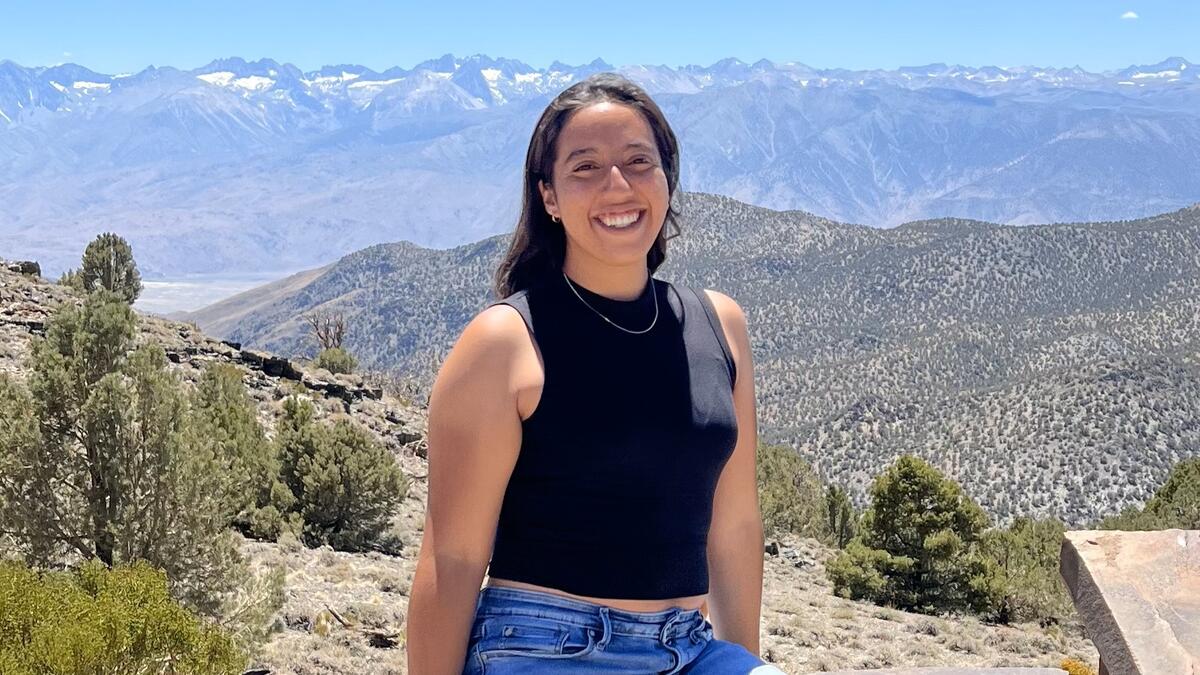Graduating student discovered her passion for conservation biology thanks to ASU

Fanny Sanchez Villarreal is graduating from ASU's School of Sciences with a degree in biological sciences, concentrating on conservation biology and ecology, and a minor in Spanish.
Editor’s note: This story is part of a series of profiles of notable spring 2024 graduates.
Growing up, Fanny Sanchez Villarreal hadn’t heard of conservation biology until she started her biological sciences program at ASU's School of Life Sciences; however, she knew she loved ecology.
“I’d always been surrounded by nature growing up (in Redwood City, California), and knew I wanted to be a part of the solution towards climate action and species conservation. I loved the idea of doing field research and knew that that’s what I wanted to stick to leading me to my specific major, biological sciences, with a concentration in conservation biology and ecology,” she said.
“Fanny has been working for us since October 2022 where she had been running a hydroponics facility to grow wheatgrass that is the ‘base of the food chain,’ so to speak, that supports a large grasshopper and locust colony in the lab," said Rick Overson, research scientist with the Global Locust Initiative and a senior Global Futures scientist at ASU. "The work requires lots of time sensitive tasks and coordinating with a larger team. She has also assisted with various other research projects that graduate students are working on in the lab. She is a Doris Duke Conservation Scholar and has participated in events and internships in California throughout her tenure as an undergraduate while masterfully balancing her time between this and many other commitments at ASU.”
After graduation, she says she plans on taking a gap year to find jobs or other fellowships to help solidify what she wants to hone in on graduate school.
She says that “through Dr. Gillian Gile and Kali Swichenberg's MEDE-CURE program, I have a new found love and appreciation for microbiology and hope to continue working more on the genetics side of conservation involving eDNA.”
Question: What’s something you learned while at ASU — in the classroom or otherwise — that surprised you or changed your perspective?
Answer: Everything is so interconnected. Throughout my degree I took a variety of courses that I thought they didn’t have much to do with science and were a form of personal exploration of identity. As I took more of these philosophical or courses revolving around humanities, I realized how concepts had hints of science in them or how science can lead us in understanding growth in different dimensions yet not needing to be the main focus.
An example of this is the world religions course at ASU. It discussed the importance of environmental science and sustainability by reflecting how communities use the environment for religious practices and how they’re being affected through climate degradation. Another example is a course I took on Aztecs, Incas and Mayans which taught us how medicinal practices were used in ancient civilizations.
Q: Why did you choose ASU?
A: I chose ASU because of its departments in science. I think it’s a great research institution, especially in the area of insect ecology. I’ve been involved with two amazing labs over the past months: Dr. Cease's Lab, the Global Locust Initiative Lab and the Microbial Eukaryotic Diversity and Evolution Research Experience course with Dr. Gillian Gile. Seeing this institution also open the Future of Oceans college recently is exciting to see for prospective students.
Q: Which professor taught you the most important lesson while at ASU?
A: Dr. Jesse Senko and his PhD student Cindy Vargas who I did my FIS 494: Sea Turtles, Sharks and Fisheries of Baja California study abroad course with. I’d also like to give recognition to a former TA of mine, Amalie Strange, who I met my freshman year of college and has been one of the greatest people I’ve come across at ASU.
Q: What’s the best piece of advice you’d give to those still in school?
A: Never feel out of place in any degree of study. One thing I’ve learned being in a STEM field as a first-generation college student and person of color is that I’ve been able to find my groups of communities, and that helped immensely with any struggles that I’ve come across.
Q: What was your favorite spot on campus, whether for studying, meeting friends or just thinking about life?
A: The secret garden (on the Tempe campus) was my favorite hangout spot with my friends because it has some of my favorite types of trees and it is always so tranquil.
Q: What are some of your favorite memories from your time as an undergraduate student? What surprised you about college?
A: Some of my favorite memories as an undergrad was getting to travel the state of California doing research with the UCSC Doris Duke Conservation Scholars Program and doing marine mammal research this past summer at the Williams lab at UCSC, looking at the peripheral vasculature system in bottlenose dolphins.
More Sun Devil community

ASU students receive $25,000 scholarships from NBA legend Magic Johnson
By Henry Smardo Serenity Reynolds Cronkite student Serenity Reynolds balances classes, homework, clubs, internships and jobs, and tuition is always top of mind. She…

ASU Accessibility Awareness Day advocates for a more inclusive digital future
By Jonathan CrowellAs technology continues to drive learning and research innovations, so do efforts to ensure digital products and environments are accessible by all.Last week, Arizona State…

ASU student, Navy vet pursues greener future in sustainability
As Arizona State University holds its annual Salute to Service celebration, honoring individuals who serve the nation and their communities, Shana Harly stands out for her commitment to both her…